|
WOOLLY
MAMMOTH BONE
Pleistocene Age
Woolly
Mammoth Bones recovered from the bottom of the North Sea, between England
and the European continent. The bones come from a depth of 65-165 feet where
they were deposited during the last ice age. The Mammoth remains are
approximately 11,000-110,000 years old. This area was once exposed when the
sea level was lower, and was an area of plains, rivers, and lakes. These
Mammoth bones are recovered by fishermen as their nets scrape the bottom of
the North Sea. These are not fossilized - they are actual bone. |
|
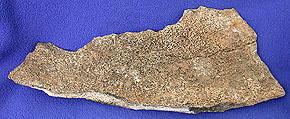
#FS-79 Woolly Mammoth Bone. Partial leg bone specimen. 14.5" long.
$100.00
|
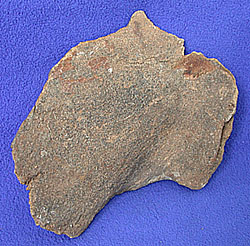
#FS-74 Woolly Mammoth Bone. Partial leg bone specimen. 8" long. $100
|
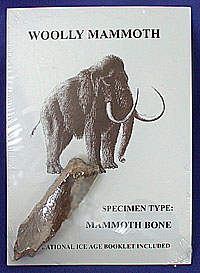
#FS-62 Genuine Mammoth Bone with informational booklet. Bone is approx.
3.5" - 4.5" long. $50
|
|
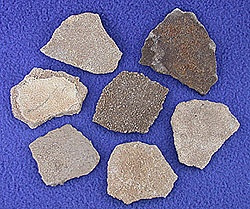
#FS-67 Dinosaur Eggshell fragments. You will receive a specimen from
either Saltasaurus or Titanosaurus. Late Cretaceous Period, about 83 to 79
million years ago. Pieces are about 1" - 1.25" long.
|
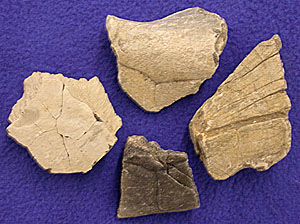
#FS-86 Fossilized Turtle Shell fragments from the USA, Oligocene era
(approx. 35 million years old.) Sizes and shapes vary, approx. 1.25" - 1.5"
long.
|
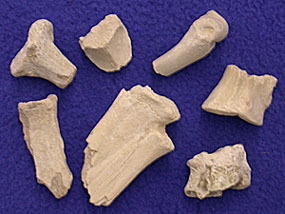
#FS-83 Fossilized Bone of the Oreodon, an extinct mammal from the USA,
Oligocene era (approx. 35 million years old.) Bone fragments approx. 1.5" - 2.5"
long.
|
|
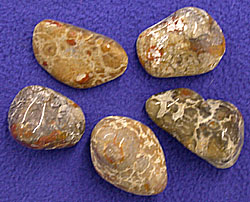
#FS-85
Tumbled Coprolite - fossilized poop! Approx. 1.5" - 2" long.
|
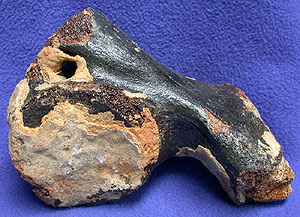
Woolly Mammoth Bones specimen,
email for current supply
|

#FS-79 Woolly Mammoth Bone. Partial leg bone specimen. 14.5" long. $100
|
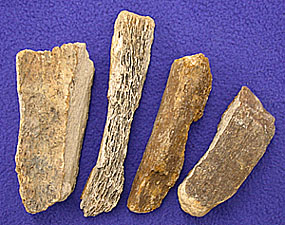
#FS-84 Genuine Mammoth Bone, from the Pleistocene Age, found in the North Sea.
Approx. 3" - 5" long.
|

#FS-131 Brachiopod Fossil, from the Devonian Period.
Mucrospirifer Thedfordensis. Found in Arkona, Ontario, Canada. About 1.25" -
1.5" long.
|
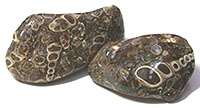
#T-TU Tumbled Turitella Fossil. Fossilized shells in matrix. Approx. 1.25" -
1.75" long.
|
|
|
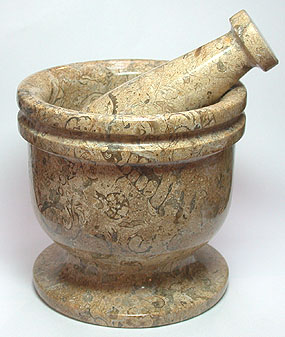
#MOR-3 Fossil Stone Mortar & Pestle Set. These mortar and pestle sets are carved
from solid pieces of fossil stone. Each is just under 4" tall and 4" in
diameter. Imported from Pakistan. $100 each
|
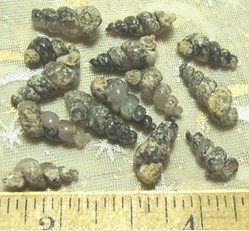
Gastropod Fossil Shells
These are small Gastropod Fossil Shells, they are often found in
Turritella Agates.
Fossil - In ancient times they were believed to be "gifts from the stars" and
have been used to enhance telepathic communication between worlds, present, past
and future. Helps bring forth accomplishments in the business world and bring
quality and excellence within our environment. Helps us open up and be more
receptive to new and innovative forces that are open to us. Helps allow the old
programming and schedules to dissipate.
Shell - They are good to help bring boundless in all areas of our lives. It can
stimulate intuition, sensitivity, imagination and adaptability. It can heighten
mental clarity and can ready us for times of decision making and insight into
what options are best. It helps with cooperation between ourselves and others.
It can provide an energy that will help keep the group working together
effectively.
$39.99
|
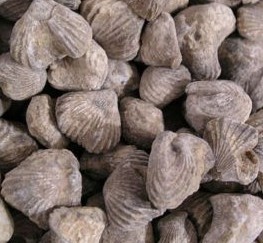
Brachiopod of
Paleozoic age
Apart perhaps from the trilobite, no other organism typifies the Age of
Invertebrates more than the brachiopod. They were the first bilaterian animals
to lose their mobility and encase their bodies in a solid external shell.
Despite a superficially similar appearance to clams, they are actually
completely different in their anatomy, belonging to the group known as the
Lophophorata, which use a fringe of tentacles known as the lophophore to sweep
food particles into their mouths. Brachiopod's are rare today, but during the
Paleozoic era (especially from the Middle Ordorvician period onwards) they
absolutely dominated every benthic (bottom-living) marine ecology. The fossils
offered here are from the Silurian period of the Paleozoic age and were found in
the fossil fields of northern Africa. sized approximately 3/4 inch to 1
1/4 inch $29.00 3/4 inch
$35.00 1 inch
$45.00 1 1/4 inch
|
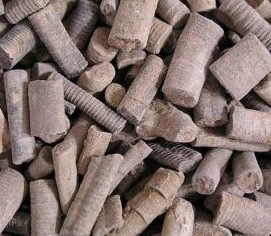
Crinoid stem fossils
devonian age
Crinoid stem fossils from the devonian age. It appears that there could be other
parts of the Crinoid included in these pieces but mostly stems,,columnals,, that
were collected from the fossil beds of northern Africa. Crinoids or "sea lilies"
are an ancient sea creature closely related to starfish. Their skeleton was
comprised of a root-like structure attached to a stem made up of many disc
shaped plates called columnals. At the top of the stem was the head or calyx
which the arms of the Crinoid were attached. The arms were used to filter food
out of the water. After death, most crinoids skeleton would fall apart leaving
behind only the columnals and small plates that made up the calyx.
$19.00 3/4 inch
$25.00 1 inch
$38.00 1 1/2 inch
$45.00 2 inch
|
|



